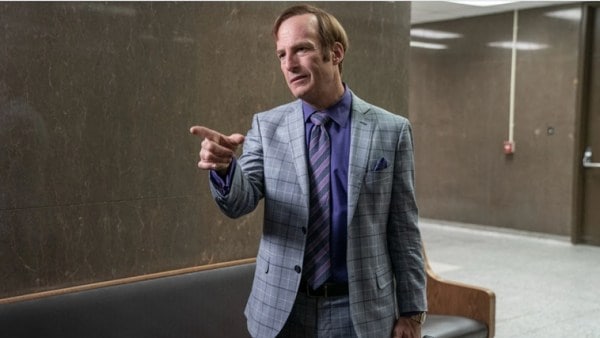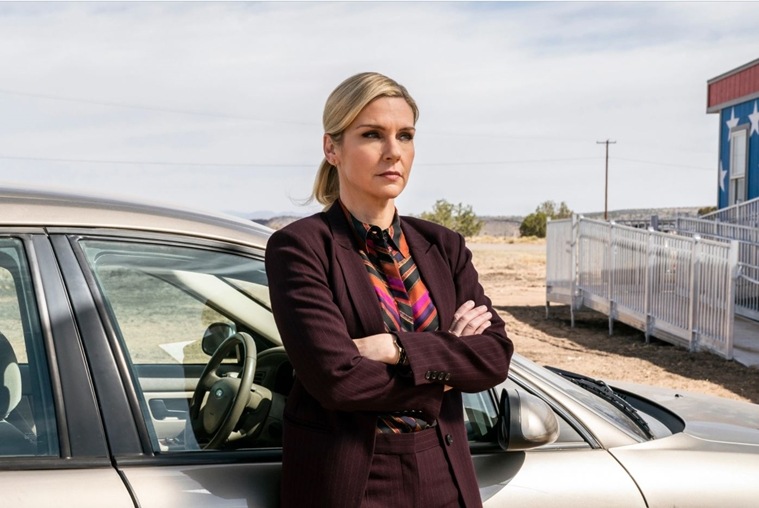 Better Call Saul season 6's first two episodes are now streaming on Netflix.
Better Call Saul season 6's first two episodes are now streaming on Netflix. In a scene from the second episode of Better Call Saul season 6, a character, high on a substance meticulously arranges several dominos in a U-shape. She gives a gentle push and knocks the first tile, producing a literal version of the domino effect, eyes full of childlike wonder. The brief scene serves as a fitting metaphor for its titular character and the show in general. Every action of Jimmy McGill, every decision he made during the show, is going to come spiralling down. It is probably safe to say when the last tile falls, things are not going to end up well for him.
From its inception as a spinoff of Breaking Bad, Better Call Saul, created by Vince Gilligan and Peter Gould (Gilligan had the sole creator credit for Breaking Bad) has cemented its place as one of the finest dramas on television, and deservedly so. Some, including me, even believe that in most respects, it is the better show. While Walter White’s rise and fall were undeniably spectacular and thrilling, if deeply despondent, Jimmy McGill’s descent into Saul Goodman, almost complete now, is a tragedy playing out in slow-motion.
Much before White began Heisenberg, he was still a small-minded, egoist but brilliant chemist who thought he was robbed of a great career by others. He was just too much of a coward to give it back to the world. But Jimmy was genuinely kind and clever if a little wayward individual who felt dwarfed by the titanic shadow cast by his brother. His slide to Goodman is marked by a series of tiny falls — less entertaining at first perhaps, but much more satisfying and narratively compelling.
Admittedly, Better Call Saul has not inspired the same amount of adoration that Breaking Bad enjoyed. The reasons range from the scarcity of those “big” moments that most like that dotted Breaking Bad’s five-season run, and not being nearly as accessible.
The first two episodes of the final season of the show are now available on Netflix in India. They follow the scare of star Bob Odenkirk’s heart attack while during the filming. He thankfully recovered, and is back as everybody’s favourite fast-talk, slimy criminal lawyer one last time.
 Better Call Saul is the best show on TV right now.
Better Call Saul is the best show on TV right now. Season 6 begins with a sequence that first fools one into thinking it is a flash-forward with its monochrome colour-scheme. It morphs into pastel colours and finally gives us vivid reds and greens and blues. They are the vibrant, gaudy ties that Goodman used to wear, and the palatial house that he built from the money he got from criminals while fighting their cases. After Breaking Bad’s finale, all of it is being ransacked by law enforcement. There are several nods to earlier seasons of the show (Better Call Saul) and his relationship with Kim Wexler, but nothing to indicate that Kim was with him (or alive) during the events of Breaking Bad. This does not bode well for her eventual fate in the show.
The opening episodes set the stage for its conclusion with the same sense of urgency that characterised the finale of season 5. After the failed assassination attempt on charismatic, ruthless drug lord Lalo Salamanca (Tony Dalton) by the men sent by Gus Fring (Giancarlo Esposito), Nacho Varga (Michael Mando) is on the run and deep in hostile territory. He gets assurance from Gus’ enforcer Tyrus Kitt (Ray Campbell) that he just has to lay low and hide for now.
 Kim Wexler’s eventual fate remains uncertain.
Kim Wexler’s eventual fate remains uncertain. Mike Ehrmantraut (Jonathan Banks) tells Gus, who is dubious about Lalo’s death, that Nacho has done what he was asked (letting the assassins in) and should earn his respect. He also stands firm before the kingpin when he asks Tyrus to bring Nacho’s father. He basically matches Gus stare for stare, something few dare to do.
Jimmy and Kim draw up a plan to discredit Howard and despite his misgivings, Jimmy, now very much the Saul Goodman we know, decides to goe with it.
Everything that made its earlier seasons fantastic is here in season 6, only turned up to 11. The acting is still phenomenal, the writing is top-notch, the cinematography remains stunning yet understated, and the subtle touches and motifs are all there.
When Better Call Saul was announced, there were concerns as to how it would create that sense of suspense if the viewer already knows what becomes of its central character and many other dramatis personae. The show allayed those fears with good old-fashioned writing and storytelling that marked the parent series. In one scene during the aforementioned standoff between Mike on one side and Tyrus and Gus on the other, we fully well know all three of these characters are alive when Breaking Bad (and none after) begins, but thanks to the craft of the people behind and in front of the camera, the scene still manages to be tense. Also, the show has several characters whose eventual fates remain uncertain.
Better Call Saul is back for its final season, and it is better than ever. The only negative thing I have to say about the show is its end is near.
- The Indian Express website has been rated GREEN for its credibility and trustworthiness by Newsguard, a global service that rates news sources for their journalistic standards.

